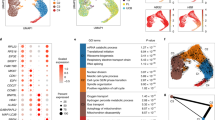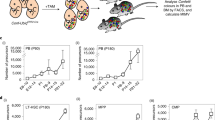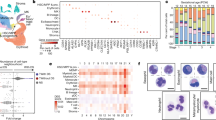Abstract
In most primates and a few mammals (cattle, sheep, goat), fetal erythropoiesis, characterized by predominant synthesis of fetal haemoglobin, is replaced around birth by adult erythropoiesis1–3. In mice, fetal erythrocytes all express an antigen (Ft) that disappears after birth4 and can be used as a marker for studying murine fetal and adult erythropoiesis. Murine haematopoietic tissues contain pluripotent stem cells (CFU-S) which give rise to splenic colonies when infused in irradiated adults5, committed erythroid precursors (BFU-E) that give rise to large bursts in vitro and more mature precursors (CFU-E) which produce small colonies in vitro6–8. We have now studied the expression of Ft antigen on these precursors, and their ability to produce colonies of Ft antigen-positive or -negative erythrocytes. Our results show that Ft antigen is not detected on the surface of erythroid precursors. Erythrocytes from splenic colonies are also Ft negative. However, erythrocytes from bursts and colonies derived from fetal liver BFU-E and CFU-E (and not from adult bone marrow) all express the Ft antigen, demonstrating that expression of the antigen is programmed very early in the erythropoietic sequence. Moreover, we have observed that after birth a decreasing number of CFU-E are able to give rise to Ft+ colonies.
This is a preview of subscription content, access via your institution
Access options
Subscribe to this journal
Receive 51 print issues and online access
$199.00 per year
only $3.90 per issue
Buy this article
- Purchase on Springer Link
- Instant access to full article PDF
Prices may be subject to local taxes which are calculated during checkout
Similar content being viewed by others
References
Wood, W. G. Br. med. Bull. 32, 282–287 (1976).
Weatherall, D. J. & Clegg, J. B. Cell 16, 467–479 (1979).
Wood, W. G. et al. Nature 264, 799–801 (1976).
Blanchet, J. P. Devl Biol. 66, 1–7 (1978).
Till, J. E. & McCulloch, E. A. Radiat. Res. 14, 212–222 (1961).
Stephenson, J. R., Axelrad, A. A., McLeod, D. & Shreeve, M. M. Proc. natn. Acad. Sci U.S.A. 68, 1542–1545 (1971).
McLeod, D. L., Shreeve, M. M. & Axelrad, A. A. Blood 44, 517–534 (1974).
Axelrad, A. A., McLeod, D. L., Shreeve, M. M. & Heath, D. S. Proc. 2nd. int. Workshop Hemopoiesis in Culture (ed. Robinson, W. A.) 226–237 (U.S. Government Printing Office, Washington, 1973).
Blanchet, J. P., Samarut, J. & Mouchiroud, G. Blood 54, 1091–1100 (1979).
Mouchiroud, G. & Blanchet, J. P. Blood 57, 586–591 (1981).
Papayannopoulou, T. et al. Blood 53, 446–454 (1979).
Papayannopoulou, T., Brice, M. & Stamatoyannopoulos, G. Proc. natn. Acad. Sci. U.S.A. 74, 2923–2927 (1977).
Stamatoyannopoulos, G. et al. Blood 54, 440–450 (1979).
Kidoguchi, K., Ogawa, M., Karam, J. D., Wilson, J. M. & Fitch, M. S. Hemoglobin 2, 503–512 (1979).
Zanjani, E. D., McGlave, P. B., Bhakthavathsalan, A. & Stamatoyannopoulos, G. Nature 280, 495–496 (1979).
Vainchenker, W. et al. Blood 56, 541–548 (1980).
Author information
Authors and Affiliations
Rights and permissions
About this article
Cite this article
Mouchiroud, G., Blanchet, J. Fetal antigen expressed on mouse erythrocytes is programmed at the early precursor stage in fetal liver. Nature 293, 156–158 (1981). https://doi.org/10.1038/293156a0
Received:
Accepted:
Issue Date:
DOI: https://doi.org/10.1038/293156a0
Comments
By submitting a comment you agree to abide by our Terms and Community Guidelines. If you find something abusive or that does not comply with our terms or guidelines please flag it as inappropriate.



